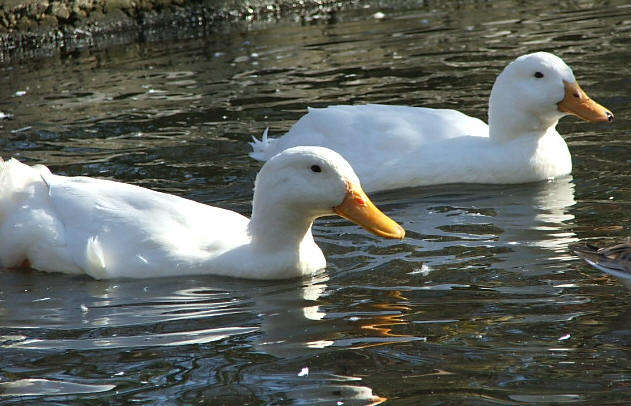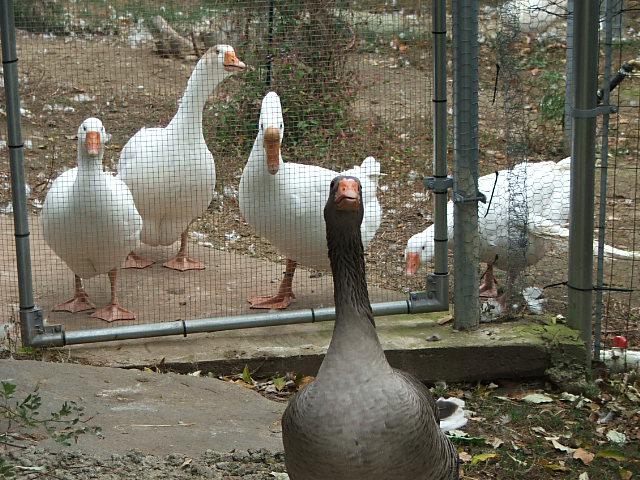Miri & Benny
Since losing her best
friend Glory in August, Miri has been a bit of a loner at
our sanctuary. We have been doing all we can to afford her
special attention and foster a belonging between her and the
other hens, but in the end it was Benny who healed her
broken heart.
At 10 years old, Miri
has been at our sanctuary for nearly 2 years. She is
arthritic from age and walks slowly and rests a lot. And
since August, she has been mourning the loss of her
life-long friend.
Her sadness finally
dissipated when Benny joined the flock. Benny has one
damaged knee joint and Miri seemed to recognize the
similarity between Benny and Glory--who also experienced
life on injured legs. Miri took to Benny immediately. They
spend every bit of their time together, either swimming on
the pond, or sleeping under the berry trees on shore. When
Miri walks, she waits for Benny to catch up with her before
continuing.
We are so pleased to
see this healing with Miri and so pleased to have Benny here
with us, mending our hearts as well as hers.

Come Join The
Gaggle!
The
How-To of Goose Introductions:
We are continually asked about goose
introductions and how to safely accomplish adding new
members to an existing gaggle. We have always been pretty
successful with new introductions, so we thought we'd share
our methods with you.

Mac,
Fanny, Jett, Joop! & Lewy become fast friends
While newcomers are held in their
quarantine pen we make personality evaluations. Mild
mannered geese are often easy to slip into a flock of geese
because they will quickly give in to an existing alpha
gander. Hens are also easy to add to an existing flock of geese.
Tempered ganders, on the other hand, can be difficult and
take some time to
integrate.
Fall and Winter introductions are
always easiest because ganders are calmer during this time
of year. This isn't to say introductions cannot take
place in Spring or Summer, but the process usually takes
more time.
Mac & Fanny have been at our sanctuary
since March of this year. Mac is our alpha gander and
although he came to us quite naughty, he has since learned
some pretty good manners and has turned out to be a very
wise leader. He is very good at maintaining flock order and
settling any squabbles between other ganders in his pen. He
is also the first to sound out warning calls when visitors
come to the sanctuary and will actively stand guard and keep
a watchful eye when strangers enter his pen or even the
neighboring duck pens. In addition to all of this, Mac has
quite the ego and he loves to be in charge. All these things
add up to mean that although Mac is great with geese he
knows, he is very wary of newcomers in his pen.
Introductions are actually pretty easy.
When new geese arrive and finish their quarantine regime, we move them to
a pen that neighbors Abby's Goose Run--Mac's pen. The
wire between adjoining pens must have a tight enough weave to
prevent ganders
from poking their bills through should they attempt to fight
through the fence. We simply zip-tie welded wire mesh to
our regular fencing. This barrier goes up about 3 feet from the
ground and prevents any bill injuries between opposing ganders.
Since we are most commonly asked how to
introduce more aggressive ganders, let's go through this
tougher scenario first, then we will cover the easier
introductions which include hens and timid ganders.
Tough Guys
Mac will initially sound the alarm and
run over to see who the new geese are in the neighboring pen. Sometimes
hissing will ensue and some vain attempts at fighting
through the fence. This was the case over the summer when we
moved two new misbehaved ganders next to
Mac.
Duran Duran were two ganders who were so naughty at first
that we split them up and put each Duran into their own
pen. Their pens neighbored each other and they were both adjacent to Mac's pen. This
enabled us to do some good hands-on interaction with each of
the Durans while preventing them from ganging up on us. There is strength
in numbers and simply by separating the two into different
pens, we were able to break down their walls and quickly
earn their trust. It was vital that the Durans pens
were side-by-side to prevent stress to them. While we worked on their manners,
they each worked on getting to know Mac. Because each
of the Durans were in their own pen, they each had to face
Mac through individually. They could not team up to confront
him.
After about two weeks it became
apparent that the bickering through the fence had ended and
Mac was even considering himself Duran Duran's protector. At
this point, we opened the first gate and let the more
dominant Duran out into The Goose Run first. Mac confronted
Duran and showed him he was boss by holding his wings out in
display and nipping at the back of Duran's neck. Duran
signaled compliance by running away. This
confrontation can last anywhere from a few seconds to nearly a
minute. Once the pecking order is set, the event is commonly
over.
If you do not allow enough time for
ganders to get to know each other through the fence, or if
you are introducing during the mating season, this display may
last longer or be more aggressive.
Two ganders vying for alpha leadership
will wrestle with their necks, each trying to get the back
of the other gander's neck and pin the other down. The
first to give up and run away loses. Although it is an
adrenaline-packed moment, as long as this wrestling match is
short-lived and someone gives up and runs away, you are
witnessing normal behavior. If you break it up too soon,
they will just go through it again next time, so try to give
them the opportunity to work out their hierarchy without
interference. There can be some running and chasing during
this initial conflict, so be careful to remove any tripping obstacles
from their pen when you do the
introduction. If neither gander gives up within the
first 30-45 seconds and their energy is not tapering off,
you should step in and break them up and put them back into
neighboring pens for a couple more weeks before trying
again.
During these introductions, hens in the
existing gaggle can commonly be observed cheering on their
gander; however, they are normally wise enough to keep
themselves well out of harms way. Subordinate ganders also
tend to stay out of the way unless they are called in to
help. Should this happen, give the two ganders a few seconds
to try to resolve the situation. If it appears that things
are escalating, or just not tapering off, then separate the
newcomer and return them back to their neighboring pen.
Keep yourself calm and maintain a
healthy perspective. Remember, much of what you are seeing
is part of their display. Outspread wings are meant to look
impressive, so don't be startled. A little bit of running
around the pen is not likely to result in injury, provided
the grounds are safe. If one gander grabs at the
feathers behind the other gander's neck in an attempt to pin
him down, they should be just fine--give them a chance to
resolve it. Don't assign too much importance to display;
instead keep a keen eye focused on actual physical contact
and escalation of aggression. You don't want to stop the
display, but you do want to
prevent someone from getting hurt.
When Mac first joined us, Tutter and
Angelo tag-teamed him. Angelo was the alpha in those days
and he called Tutter in to back him up. Neither side was
able to win the bout and neither were willing to concede.
Within 30 seconds we were able to determine that the time
had not come yet for this introduction. We removed Mac from
the pen and gave them more time to get used to each other on
opposite sides of the fence.
Some geese acclimate immediately, some in weeks and others
still, take months.
Once the new order is set between alpha
ganders, you can then focus on introducing new subordinates.
These introductions should be pretty uneventful--a quick
chase. We always let the dominant gander enter Mac's pen
first and then proceed with allowing any subordinate geese
into the pen one-by-one.
Once introductions are complete, it
will take anywhere from a few days to a few weeks for the
gaggle to become cohesive. Fighting should be over, but you
will see a bit of uneventful chasing or nervous/uncertain
behavior during this time. It is best to have multiple food
and water sources to prevent anyone from going hungry or
thirsty.
Nice Guys & Gals

Mac
meets Jett & Joop!
When Jetti (goose) and Joop! (gander)
came to join us they only stayed in a neighboring pen for 15
minutes before entering the Goose Run with Mac. Although
some calling through the fence took place initially, it
quickly settled into disinterest amongst both groups. There
was no hissing and more signs of curiosity than aggression.
Since Joop! is the dominant of the pair, we let him out into
the pen with Mac first. Mac chased him, Joop! ran and then
they were suddenly friends. We let Jetti out next without any
incident at all.
Nervous Guys

"Hey, who's the new guy?"
The same was true when we introduced
the nervous Lewy to the Goose Run a couple weeks later.
After 15 minutes on the other side of the fence, we could
tell by the gaggle's behavior and calls that they wanted to
meet the newcomer. We opened the gate and let Lewy out. The
meeting
was uneventful; Mac chased, Lewy ran and it
was over.

